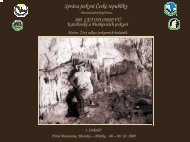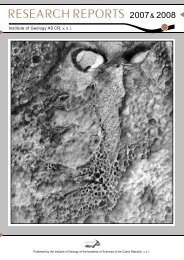triradiate locomotion Triadobatrachus evidenced segmentation
Get PDF (915K) - Wiley Online Library
Get PDF (915K) - Wiley Online Library
You also want an ePaper? Increase the reach of your titles
YUMPU automatically turns print PDFs into web optimized ePapers that Google loves.
32 Development of the pelvic skeleton in frogs, H. RoCková and Z. RoCek<br />
The hypochord develops simultaneously with the<br />
neural arches in an anterior–posterior direction; it is<br />
first represented by a median strip-like aggregation of<br />
fibrous connective tissue extending antero-posteriorly<br />
along the whole ventral surface of the notochord,<br />
which later (when cartilaginous 10th and 11th neural<br />
arches appear) chondrifies in its postsacral region<br />
(Mookerjee, 1931). In the Pipidae and extinct Palaeobatrachidae,<br />
the hypochord in the postsacral region<br />
ossifies independently of neural arches (Fig. 7N; see<br />
also 9pinar, 1972; RoCek, 2003); both coalesce with<br />
each other (and with the sacral vertebra) only in the<br />
fully grown adult. It should be noted that Hodler (1949)<br />
considered the posterior extent of the cartilaginous<br />
hypochord as a landmark indicating the posterior end<br />
of the urostyle in the adult. The caudal hypochord is<br />
interpreted as fused vestigial caudal haemal arches<br />
(basiventralia) in which <strong>segmentation</strong> vanished (Mookerjee,<br />
1931; Mookerjee & Das, 1939); in contrast,<br />
Mahendra & Charan (1972) argued against the idea of<br />
the urostyle being formed from the caudal vertebrae.<br />
Griffiths (1963) noted, without further comment, its<br />
continuity with the first postsacral intervertebral body<br />
in Megophrys.<br />
One of the last events in the development of the pelvis<br />
is constitution of the ilio-sacral articulation. This is<br />
due to late development of the sacral diapophyses. The<br />
sacral diapophysis takes its origin independently of the<br />
neural arch (in the present study we were able to find<br />
evidence for this on histological sections of Discoglossus,<br />
which was the only species in which we have sections<br />
through the pelvis region in all developmental<br />
stages). Ribs on the vertebrae within pectoral and even<br />
posterior praesacral regions of the vertebral column<br />
are known in adults of primitive living anurans<br />
(Ascaphus, Leiopelma, Discoglossus); in the Pipidae and<br />
Palaeobatrachidae, however, they fuse with the transverse<br />
processes only in fully grown adults (Nevo, 1968;<br />
RoCek, 2003), or are present at least in early periods of<br />
larval development in Rana, Hyla and Pelobates where<br />
they later coalesce with the transverse processes<br />
(Mookerjee, 1931; Blanco & Sanchiz, 2000). As the<br />
proanuran <strong>Triadobatrachus</strong> still possessed well-developed<br />
sacral ribs (Rage & RoCek, 1989; Fig. 8D), it might be<br />
supposed that anuran sacral diapophyses have the<br />
same origin.<br />
The peculiar condition in swimming anurans (e.g.<br />
Xenopus, Palaeobatrachus, Bombina), in which the<br />
tips of their iliac shafts reach far beyond the anterior<br />
margin of the expanded and fluted sacral diapophyses,<br />
may be caused by insertion of the ilio-lumbaris muscle<br />
on the transverse processes of presacral vertebrae 4–6<br />
(Emerson, 1982); according to different theories, this<br />
peculiarity may have had a functional role in the mechanisms<br />
of breathing, food capture or shock absorbence<br />
(Willem, 1936, 1938a,b; Palmer, 1960; Whiting,<br />
1961; see Van Dijk, 2002, for a more comprehensive<br />
discussion).<br />
We noticed some differences in the timing of developmental<br />
events among species (Table 1). For instance,<br />
development of the hypochord in Bombina is obviously<br />
retarded if compared with Discoglossus. The hypochord<br />
and caudal vertebrae appear comparatively late<br />
in Bufo.<br />
As our investigation mainly concerned developmental<br />
series until stage 66, we were not able to follow<br />
later development, including the mode of ossification<br />
and fusion of the sacral diapophyses with the first postsacral<br />
or most posterior presacral diapophyses. Transverse<br />
processes from the urostyle may contribute to<br />
formation of the ilio-sacral articulation, fuse to the sacral<br />
diapophyses or replace sacral diapophyses in this<br />
function in Pelobates and Scaphiopus (Ritland, 1955).<br />
Summary<br />
1 The anuran pelvis develops from two chondrification<br />
centres on each side of the body, which arise shortly<br />
one after another and soon fuse together; they may<br />
be interpreted as the pubo-ischiadic and iliac plates,<br />
respectively. The former corresponds to the pelvis of<br />
piscine ancestors of amphibians.<br />
2 Posterior rotation of the pelvis from its original vertical<br />
position, together with reduction of the tail,<br />
undoubtedly reflects evolutionary changes that occurred<br />
in temnospondyls; they resulted in functional changes<br />
of some thigh muscles, and were obviously a device for<br />
saltation and swimming.<br />
3 The tuber superius on the iliac shaft is probably<br />
homologous with the iliac process of early amphibians,<br />
and is not correlated with saltation/swimming. It is a<br />
place of origin of the m. glutaeus maximus (a homologue<br />
of m. iliotibialis of tailed amphibians), which<br />
plays only a limited role (extension of knee joint) in<br />
jumping or swimming.<br />
4 Development of the pelvis closely behind the level of<br />
the sacral vertebra seems to be associated with the type<br />
of ilio-sacral articulation (modified for longitudinal<br />
© Anatomical Society of Great Britain and Ireland 2005





